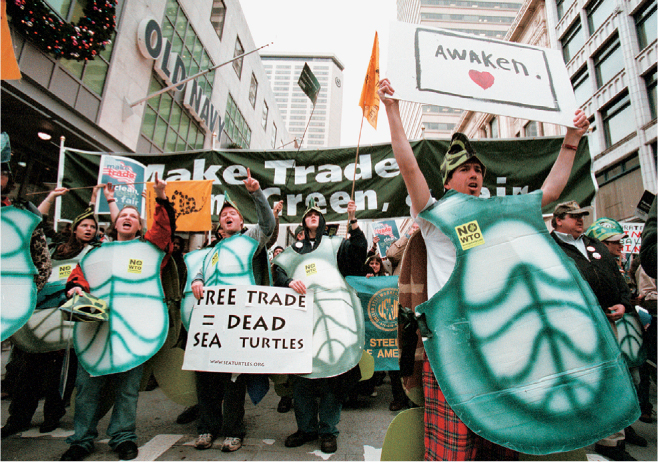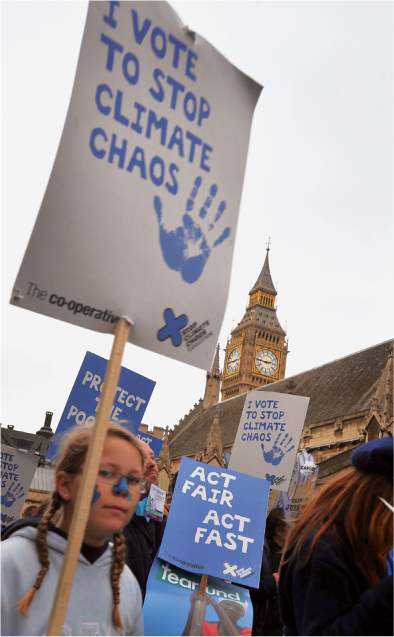Chapter Introduction
367
International Agreements: Trade, Labor, and the Environment
This chapter explains the rationale for international trade agreements, including regional trade agreement as well as WTO. It then extends the discussion to assess how trade agreements, and other multilateral agreements, address pressing non-economic issues such as fair labor standards and environmental quality.
- International Trade Agreements
- International Agreements on Labor Issues
- International Agreements on the Environment
- Conclusions
Seattle was a riot, they tried to pin on us.
But we didn’t show up, with gas and billy clubs
An un-armed mass of thousands, just trying to be heard.
But there are no world leaders that want to hear our words.
Lyrics from “Seattle Was a Riot” by the punk-rock band Anti-Flag, 1999
We now have a Copenhagen Accord which I think contains a number of very significant elements…. But not an accord that is legally binding. Not an accord that, at this moment, pins down industrialised countries to individual targets. Not an accord that at this stage specifies what major developing countries will do.
Yvo de Boer, Executive Secretary of the United Nations Framework Convention on Climate Change, December 19, 2009
1. Protests at WTO meetings: Why? Because liberalizing trade also affects environmental policy. Countries that are excluded from a foreign market on the basis of unreasonable environmental standards can appeal to the WTO.
2. Purpose of the chapter: Explain why international agreements like WTO—as well as international agreements on climate change—are needed.
a. A large country can benefit from an import tariff because it turns the TOT in its favor. However, if another large country also imposes a tariff, the effects on the TOT offset each other, and both are hurt.
b. International agreements to reduce tariffs and encourage free trade can preclude such perverse outcomes.
c. At the global level, an example is the WTO itself. Regional trade agreements include NAFTA, the EU, and ASEAN. Proposed regional trade agreements are the Trans-Pacific, Trans-Atlantic, and European-Japan free trade areas. These proposed regional agreements have developed in response to the collapse of the Doha Round of the WTO.
d. Trade agreements often also address labor and environmental issues. Global externalities like carbon dioxide require international agreements, such as those attempted at Kyoto and Copenhagen.
In 1999 policy makers from around the world met in Seattle, Washington, to discuss the next round of trade negotiations under the World Trade Organization (WTO). But the meeting never achieved that goal because it was disrupted by large groups of protesters who filled the streets. The protest at times turned violent (as described in the lyrics above from “Seattle Was a Riot”). The scale of these protests took many people by surprise; after all, discussions about trade reform had been occurring since the General Agreement on Tariffs and Trade (GATT) was formed in 1947, but never before had there been such an organized protest against it. What explains this grassroots movement against the WTO?
In past rounds of negotiations, the GATT and now the WTO have been successful in lowering tariffs in most sectors of its members’ economies. The barriers to trade remaining for the WTO to address now go beyond tariffs and involve issues of national interest that are indirectly related to trade. One of those issues is the environment. Most countries have national laws governing environmental issues, such as the use of pesticides or genetically modified organisms, the protection of endangered species, the extent to which firms can release pollutants into the atmosphere, the harvesting of renewable and nonrenewable resources, and so on. Inevitably, some of these rules will also affect international trade, and that is where the WTO comes in. Under the Uruguay Round of negotiations (1986–1994), the WTO toughened its own rules governing the extent to which national laws can affect international trade. Countries that believed they were excluded from a foreign market because of unreasonable environmental standards there could bring a dispute before the WTO, where a panel of judges in Geneva would rule on the case. In principle, the panel’s ruling would be binding on the countries involved.
368

The new WTO rules governing environmental regulations infuriated grassroots groups in the United States and abroad. Just before the Seattle meeting, these environmental groups formed a coalition with union leaders, religious groups, third-world activists, and others who believed that the WTO might threaten the interests of those whom they represent. In addition, a wide range of political groups—from conservatives to anarchists—believed it was undesirable for a WTO panel in Geneva to make rulings that would affect U.S. regulations. Members of all these groups gathered in Seattle to voice their dissatisfaction with the WTO. The environmentalists dressed as dolphins, turtles, and other endangered species that had been affected by recent WTO rulings. The scenes of these costumed creatures marching arm in arm with steelworkers gave an entirely new image to protests against the WTO.
Protests over the environment were also evident at a meeting 10 years later, in December 2009, held in Copenhagen, Denmark. Called the Copenhagen Climate Summit, this international meeting was supposed to establish binding reductions for countries’ emissions of greenhouse gases. Hundreds of protesters were arrested and thousands more attended rallies, some dressed as polar bears and panda bears to highlight the threat of global warming to the habitat of those animals. Although expectations for the summit were high, the meeting unfortunately broke up without any binding commitments from countries to reduce their greenhouse gas emissions, as indicated in the quotation at the beginning of the chapter from Yvo de Boer, who was, at the time, Executive Secretary of the United Nations Framework Convention on Climate Change.1

The goal of this chapter is to examine why international agreements like those negotiated under the WTO for trade, and those negotiated for environmental reasons like the Copenhagen Climate Summit, are needed. We begin by reviewing the reasons why international agreements dealing with tariffs are needed. As we discussed in an earlier chapter, countries that are large can influence the price they pay for imports by applying an import tariff: the tariff increases the import price for consumers in the large country but lowers the price received by foreign exporting firms. The reduction in the price received by exporters is a terms-of-trade gain for the importing country. In this chapter, we show that when two or more countries apply tariffs against one another in an attempt to capture this terms-of-trade gain, they both end up losing. The terms-of-trade gain for one country is canceled by the use of a tariff in another country, so both countries wind up losing as a result of the tariffs.
369
To avoid such losses, international agreements to reduce tariffs and move toward free trade are needed. These international agreements take several forms. The WTO is a multilateral agreement, involving many countries, with agreement to lower tariffs between all the members. There are also smaller regional trade agreements, involving several countries, often located near one another. The North American Free Trade Agreement (NAFTA) and the European Union are both examples of regional trade agreements, which lead to free trade among the countries who are parties to the agreement. A recent example is an agreement between China and the Association of Southeast Asian Nations (ASEAN) for the China–ASEAN free-trade area. That agreement eliminated tariffs on 90% of products traded between China and six members of ASEAN—Brunei, Indonesia, Malaysia, Philippines, Singapore, and Thailand—on January 1, 2010, with the remaining four countries of the association (Cambodia, Laos, Myanmar, and Vietnam) added by 2015. This Asian free-trade area covers nearly 1.9 billion people, or more than one-quarter of the world’s population. In economic terms, it is the third largest free-trade area in the world, after the European Union (covering about 500 million people) and NAFTA (covering 444 million people).
Many new regional trade agreements that span vast regions are currently being considered. The Trans-Pacific Partnership is a proposed free-trade agreement between Australia, Brunei, Chile, Canada, Japan, Malaysia, Mexico, New Zealand, Peru, Singapore, the United States, Vietnam and South Korea. The Trans-Atlantic Trade and Investment partnership is a proposed agreement between the United States and the European Union. A Europe-Japan free-trade area is also under consideration. All of these proposed free-trade areas are a response to the failure of the Doha Round of WTO negotiations. As we saw in the last chapter, the Doha Round has foundered over the issue of agricultural tariffs and subsidies. Although it will still be difficult to bargain over the use of these policies in a Trans-Pacific, Trans-Atlantic, or Europe–Japan free-trade area, we can expect that it will be easier than when all the 159 members of the WTO are involved in the negotiations, as they have been in the Doha Round.
In addition to eliminating tariffs on trade, regional and multilateral trade agreements often address broader issues. For example, the NAFTA agreement has two other “side agreements”: one involves the rights of workers in each country, and the other involves the environment. In this chapter, we discuss the extent to which NAFTA and other labor agreements protect the rights of workers, and then we discuss international agreements on the environment. Rulings at the WTO have an indirect impact on the environment, which is what concerned many protesters in Seattle. But other international agreements, such as that attempted at the Copenhagen Climate Summit and its precursor, the Kyoto Protocol, have a more direct impact. Both of these agreements were intended to reduce carbon dioxide emissions worldwide and therefore slow global warming. We argue that for “global” pollutants such as carbon dioxide, countries do not fully recognize the environmental costs of their economic activity. So, we need international agreements to ensure that countries recognize these environmental costs. Such agreements are in the best interests of the world community, even though they are hard to achieve.
370